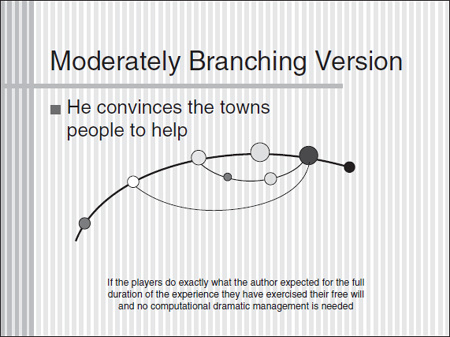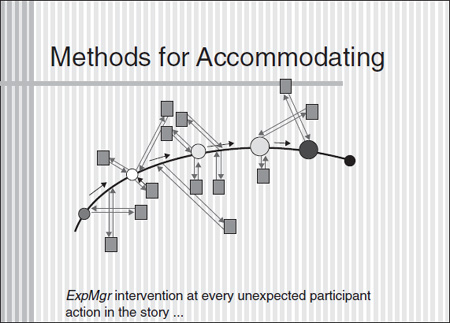10
Experience Management
In the previous chapter we talked about the need to give simulation participants a sense that they have the ability to control the progress and outcome of events so that they don’t feel that they are merely being swept along in a stream of experiences that will occur, regardless of what they do. It is also important that the interactions that they do perform are not irrelevant. Shunting action over to some side activity doesn’t do the job either. The film Titanic may be a good example of this principle. In a simulation based on the incidents surrounding the sinking of the Titanic, the actual sinking of the ship is not really the story. It’s the background. Whether or not any individual character escapes alive is their story. Creating a simulation story that allows the participants to prevent the collision and the subsequent sinking of the ship is probably to miss the point here. James Cameron understood this when he wrote and directed the highest grossing film in motion picture history to date.
He put his heroes on board the sinking ship and left them to their own devices to find a way to survive. Players in a simulated Titanic adventure would probably enjoy this aspect of the story the most—saving themselves and someone they love. What they and all simulation participants want the most is interactivity that is relevant and meaningful.
Dr. Andrew Gordon, the lead researcher on the ALTSIM project, may have stated it best when he wrote, “The central problem of creating interactive drama is structuring a media experience in which a good story is presented while participants are still able to have a high degree of meaningful interactivity.” There are many key words in that statement: “meaningful” being the most important, followed by “high degree” of interactivity and, of course, “good story.” What appears to be a struggle between the free will and free play of the participants and the events of the story itself ends up being, behind the scenes, a struggle between the participants’ desires to do what they want and the simulation system’s ability to manage, control, and enable the telling of the story.
We have already described the Leaders project, which uses a fixed branching storyline to direct players toward the simulation’s dramatic goals.
In this chapter, we will look at an alternate approach, the one we took in ALTSIM, which in its own way was even simpler than that of a branching storyline. The ALTSIM approach uses a piece of technology called the Experience Manager, which allows participants to play a very active role in a highly developed story-driven simulation.
In order to do this in the ALTSIM simulation, the Experience Manager needed to understand the story. The device Dr. Gordon came up with to make this possible was a set of formal descriptions of the actions that the player would take as the story moves along. These descriptions were based on the players’ perceptions of the events that were happening and the actions they would take based on those perceptions. That set of representations (the metadata of the story), which we called the Story Representation System, in a sense served as the Experience Manager’s coded script. When the expectations in that coded script were wrong—that is, when the participants did things other than those written in the Story Representation System—the Experience Manager called up a Story Adaptation Strategy that would adjust the participant experience. If possible, the Experience Manager would do nothing—or, if doing nothing would not allow the story to continue toward its dramatic goals, the Experience Manager would adjust the story, take the participant on a brief but temporary side track, or block the participant’s action completely.
The important elements needed to make the Experience Manager work were an effective and accurate coded script using the Story Representation System and, just as importantly, a set of story adaptation strategies that would not seem too far-fetched or intrusive, and yet would re-set the story so that it was still allowed to progress toward its dramatic goals.
EXPERIENCE MANAGEMENT
In ALTSIM, the story is told though media elements (individual video and audio clips, text messages, and graphics) that arrive at the computers of the participants in the simulated tactical operations center (TOC). The delivery of the media elements is timed to correspond to the passage of time in the story. Each media element carries with it an expected action by the player. In some cases, the actions are expected immediately or within a very limited time frame; in other cases, they are not, and sometimes it is a combination of elements that require a specific action. In rare cases, there are branches that have been anticipated in the story. These are triggered by specific actions but these branches are extremely limited: so that in fact the story has one, two, or three arcs that split and occasionally come back together as the story progresses.
When the players in the TOC encounter a media element, they take an action. As long as the encoded script of the Experience Manager anticipates the players’ actions, the story progresses on track and more media elements are delivered. If the players do exactly what the encoded script describes, they have a rewarding learning experience and the Experience Manager has had to do no more, figuratively, than to sit back and watch.
As an example, consider creating an interactive drama out of the classic western movie High Noon. Assume that the story is told through clips from the film but that additional scenes can be added using a style that matches the film but somehow does not need to employ the original actors or new dialog on their part. The reason that we are imagining this is because the copyright issues surrounding a star-studded feature film like High Noon would make it prohibitive to turn into an interactive drama. But the story is so clean and direct that the subject is irresistible. Also, High Noon, set in the most mythical old west, is perhaps the best example imaginable of a simple story that is all about decision making.
Say that somehow we got the rights to this great film. Now, imagine that in our simulation the player is asked to become Will Kane, the hero of the story, and that each segment presented ends with a question about what to do.
Figure 10.1 shows the arc of High Noon recast in the first person so that the player is the hero, Will Kane.

Figure 10.1 The story arc of High Noon.
In a sense the entire story of High Noon is about the decision to stay or run, but it is presented over and over again in different contexts. In our simulated version of High Noon the player decides what to do (if anything) and uses the computer keyboard to compose a response back to the system, e.g., “I decide to let my wife go by herself and I will stay to face the gunslingers.” In cases where the player response matches exactly what Will did in the original movie, the story moves forward and the next scene is presented, e.g., “I head into the saloon to ask some of the townspeople for help.”
If we were to create another branch to the story (the most probable branch to the events that might occur) and we create all the media to support that path, then we would still have a similar situation. As long as the participant made decisions that conformed to the path of the story that the author laid down, there is no need for any kind of intervention. The story just plays out as planned. We can even allow the sheriff to convince some or all of the townspeople to join in the confrontation.
In this case, however, to preserve the dramatic goals of the story, the sheriff needs to have a crisis moment when he knows he must face the villains alone. So the author of this new branch of the story develops a scenario in which some townspeople agree to support the sheriff but at the last minute back out again. That way the dramatic climax of the story, when the sheriff realizes that he must face the bad guys alone, is preserved. The confrontation is represented by the largest circle on the flowchart and is the most dramatic moment in the story— the moment of truth. The smaller black circle that follows is the outcome, the actual gunfight, which, though memorable and exciting, is not really what the story is all about. Once the sheriff finally decides to stay, the dramatic goals of the story have been met.
In a story-driven simulation (which has been expanded to provide one or two additional branches to accommodate the most likely alternate paths of the story, and which maintains the dramatic goals), if the player does not deviate from the established story paths, no dramatic interventions are necessary.
Notice in Figure 10.2, there are two alternate paths for the story. The path from the third circle to the largest circle represents the path when the townspeople decide to join Will and then change their minds. The path from the second circle represents the consequences of the discussion Will has with his wife. The author of this path decided to take advantage of the pedagogical opportunity presented there, so that, if Will handled the conversation badly, then his wife may not come back and save him in the end (which is what she does in the film).
Within this framework, one or two added branches or not, the central problem is how to deal with player behavior that is not anticipated in the Experience Manger’s coded script. After all, as soon as Will finds out about the bad guys, the user could respond in a way that is outside the storyline. He or she could have Will leave town the moment he gets the message. If that were the case, the next required scene would not be present in the existing movie. However, a single new scene could be added that could accommodate this action in such a way that the rest of the film would still work. For example, the new scene shown in Figure 10.3 would probably work as follows: “As Will walks back home to tell his wife about the message and his plans to leave town, he runs into a young boy who proudly says how much he admires Will and his fearless protection of the town.”

Figure 10.2 Alternate story paths for High Noon.
In this simple case, the expected action is that the boy will shame Will into staying and facing the bad guys. Note that this specific response works at a single story point as shown in Figure 10.3. But following this approach and writing and producing the media elements that would allow a separate specific adaptation response for every point in the story would be all but impossible.
Now, let’s look at that response again and rework it slightly as follows: “As Will walks from his office ready to leave town he runs into a young boy who proudly says how much he admires Will and his fearless protection of the town.” That slight redefining of the adaptation strategy would work at any place in the story where Will decides to leave town, no matter when it is. The fact is that the revised scene is a general piece of adaptation media and it is for such media that ALTSIM’s Experience Manager was designed.

Figure 10.3 A way to handle unexpected player behavior.
Let’s assume again that we have created an interactive version of High Noon by chopping up the original film into a series of sequences. For example, Will gets the letter; Will talks to his wife who says she will leave him if he doesn’t run away; Will talks to the townspeople; Will talks to his deputies, etc. At the end of every sequence the participant who plays the part of Will Kane has to make a decision. Most decisions are variations on whether or not to stand and face the bad guys in the light of increasingly negative evidence. For example, Will could decide to join his wife and run away; or make up his mind to hop on his horse and ride out of town; or he could get on the next train; or go into hiding.
We could create a decision matrix for Will by plotting the decision points at the end of the movie sequences against Will’s possible actions. If we add the option of doing nothing at all, then we really have covered all the possibilities. The Experience Manager’s job is to fill in the blanks in such a matrix, that is, to complete the formula that says, “At this moment, with this action, the way to keep the story on track is to employ this adaptation strategy.”
Figure 10.4 Story adaptation strategies applied in reaction to unexpected player behavior.
Figure 10.5 shows some examples of adaptation strategies that could be used in an interactive simulation based on High Noon. They include sending misinformation such as “he’s not really out of jail,” text messages in the form of telegrams urging Will to stay the course, and weather that makes the roads impassable so that he can’t leave town.
Once the simulation story has been represented in a way that the computer system can understand (see Chapter Twelve) and a robust set of adaptation strategies have been identified and created, what is needed is the appropriate set of rules by which the system can operate. For example, one obvious rule is that the first thing for the Experience Manager to do after the participant takes an unexpected action is to check out the consequences of the proposed action. If the storyline can continue as written, the dramatic goals met and the action can still be carried out, then that will certainly provide the most rewarding experience for the participant and give the greatest sense of personal control. Other criteria might include whether or not the adaptation strategy has been employed before. If Will Kane, for example, had already run into the young boy who tells him how proud he is of Will’s protection, then it is unlikely that the participant will be affected positively by going through the same experience again.
Figure 10.5 Examples of adaptation strategies.
SUMMARY
In this chapter we have talked about Experience Management, a system whereby simulation participants follow the arc of a prescribed story that may have one or two branching paths. As long as they stay on those paths the story stays on track. But when the participants do something that the storywriter did not intend, then it is up to the Experience Management System to get the story back on track. It does this by employing an adaptation response of some kind that either adjusts the story or blocks the participants’ new action and forces the story back on track.
The keys to successful implementation of Experience Management are (1) a way to represent the story with metadata so that the computer can understand and manipulate it, and (2) a sophisticated set of general adaptation responses that can be used to block user actions in a way that will not seem too manipulative to the participants, but which will still get the story back on track.


